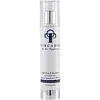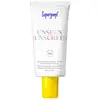What's inside
What's inside
 Key Ingredients
Key Ingredients

 Benefits
Benefits

 Concerns
Concerns

 Ingredients Side-by-side
Ingredients Side-by-side

Butyl Methoxydibenzoylmethane 3%
UV AbsorberEthylhexyl Methoxycinnamate 7.5%
UV AbsorberOctocrylene 2.8%
UV AbsorberWater
Skin ConditioningC12-15 Alkyl Benzoate
AntimicrobialEthylhexyl Methoxycrylene
Skin ConditioningGlycerin
HumectantSilica
AbrasiveVp/Eicosene Copolymer
Dimethicone
EmollientCyclopentasiloxane
EmollientPotassium Cetyl Phosphate
EmulsifyingPEG-100 Stearate
Dimethyl Capramide
Emulsion StabilisingHydrogenated Palm Glycerides
EmollientCitrus Aurantium Dulcis Peel Extract
Emulsion StabilisingCitrus Grandis Peel Extract
AstringentPrunus Armeniaca Fruit Extract
Skin ConditioningAniba Rosaeodora Wood Extract
MaskingLecithin
EmollientVitis Vinifera Fruit Cell Extract
Skin ConditioningDiaminopropionoyl Tripeptide-33
Skin ConditioningVanilla Planifolia Fruit Extract
Skin ConditioningDimethylmethoxy Chromanol
AntioxidantAcrylamide/Sodium Acryloyldimethyltaurate Copolymer
Emulsion StabilisingCitrus Aurantifolia Peel Extract
CleansingCaprylyl Glycol
EmollientDisodium EDTA
Xanthan Gum
EmulsifyingCyclohexasiloxane
EmollientCaprylic/Capric Triglyceride
MaskingSorbitan Oleate
EmulsifyingGlyceryl Stearate
EmollientGlyceryl Distearate
EmollientHexylene Glycol
EmulsifyingIsohexadecane
EmollientPolysilicone-11
Polysorbate 80
EmulsifyingPhenoxyethanol
PreservativeIsomalt
HumectantSodium Benzoate
MaskingLimonene
PerfumingLinalool
PerfumingButyl Methoxydibenzoylmethane 3%, Ethylhexyl Methoxycinnamate 7.5%, Octocrylene 2.8%, Water, C12-15 Alkyl Benzoate, Ethylhexyl Methoxycrylene, Glycerin, Silica, Vp/Eicosene Copolymer, Dimethicone, Cyclopentasiloxane, Potassium Cetyl Phosphate, PEG-100 Stearate, Dimethyl Capramide, Hydrogenated Palm Glycerides, Citrus Aurantium Dulcis Peel Extract, Citrus Grandis Peel Extract, Prunus Armeniaca Fruit Extract, Aniba Rosaeodora Wood Extract, Lecithin, Vitis Vinifera Fruit Cell Extract, Diaminopropionoyl Tripeptide-33, Vanilla Planifolia Fruit Extract, Dimethylmethoxy Chromanol, Acrylamide/Sodium Acryloyldimethyltaurate Copolymer, Citrus Aurantifolia Peel Extract, Caprylyl Glycol, Disodium EDTA, Xanthan Gum, Cyclohexasiloxane, Caprylic/Capric Triglyceride, Sorbitan Oleate, Glyceryl Stearate, Glyceryl Distearate, Hexylene Glycol, Isohexadecane, Polysilicone-11, Polysorbate 80, Phenoxyethanol, Isomalt, Sodium Benzoate, Limonene, Linalool
Butyl Methoxydibenzoylmethane 3%
UV AbsorberHomosalate 8%
Skin ConditioningEthylhexyl Salicylate 5%
UV AbsorberOctocrylene 4%
UV AbsorberIsododecane
EmollientDimethicone Crosspolymer
Emulsion StabilisingDimethicone/Bis-Isobutyl PPG-20 Crosspolymer
EmollientPolymethylsilsesquioxane
Isohexadecane
EmollientDicaprylyl Carbonate
EmollientMeadowfoam Estolide
Skin ConditioningCaprylic/Capric Triglyceride
MaskingPolyester-7
Skin ConditioningNeopentyl Glycol Diheptanoate
EmollientLithothamnion Calcareum Extract
Skin ConditioningCaprylyl Glycol
EmollientButyrospermum Parkii Butter
Skin ConditioningJojoba Esters
EmollientMannitol
HumectantBoswellia Serrata Resin Extract
SmoothingLecithin
EmollientMicrocrystalline Cellulose
AbsorbentDiatomaceous Earth
AbrasiveZinc Sulfate
AntimicrobialSilica
AbrasiveTocopherol
AntioxidantButyl Methoxydibenzoylmethane 3%, Homosalate 8%, Ethylhexyl Salicylate 5%, Octocrylene 4%, Isododecane, Dimethicone Crosspolymer, Dimethicone/Bis-Isobutyl PPG-20 Crosspolymer, Polymethylsilsesquioxane, Isohexadecane, Dicaprylyl Carbonate, Meadowfoam Estolide, Caprylic/Capric Triglyceride, Polyester-7, Neopentyl Glycol Diheptanoate, Lithothamnion Calcareum Extract, Caprylyl Glycol, Butyrospermum Parkii Butter, Jojoba Esters, Mannitol, Boswellia Serrata Resin Extract, Lecithin, Microcrystalline Cellulose, Diatomaceous Earth, Zinc Sulfate, Silica, Tocopherol
 Reviews
Reviews

Ingredients Explained
These ingredients are found in both products.
Ingredients higher up in an ingredient list are typically present in a larger amount.
Also known as Avobenzone, this ingredient is a chemical sunscreen filter that provides protection in the UV-A range.
Avobenzone is globally approved and is the most commonly used UV-A filter in the world.
Studies have found that avobenzone becomes ineffective when exposed to UV light (it is not photostable; meaning that it breaks down in sunlight). Because of this, formulations that include avobenzone will usually contain stabilizers such as octocrylene.
However, some modern formulations (looking at you, EU!) are able to stabilize avobenzone by coating the molecules.
Avobenzone does not protect against the UV-B range, so it's important to check that the sunscreen you're using contains other UV filters that do!
The highest concentration of avobenzone permitted is 3% in the US, and 5% in the EU.
Learn more about Butyl MethoxydibenzoylmethaneThis ingredient is an emollient, solvent, and texture enhancer. It is considered a skin-softener by helping the skin prevent moisture loss.
It helps thicken a product's formula and makes it easier to spread by dissolving clumping compounds.
Caprylic Triglyceride is made by combining glycerin with coconut oil, forming a clear liquid.
While there is an assumption Caprylic Triglyceride can clog pores due to it being derived from coconut oil, there is no research supporting this.
Learn more about Caprylic/Capric TriglycerideCaprylyl Glycol is a humectant and emollient, meaning it attracts and preserves moisture.
It is a common ingredient in many products, especially those designed to hydrate skin. The primary benefits are retaining moisture, skin softening, and promoting a healthy skin barrier.
Though Caprylyl Glycol is an alcohol derived from fatty acids, it is not the kind that can dry out skin.
This ingredient is also used as a preservative to extend the life of products. It has slight antimicrobial properties.
Learn more about Caprylyl GlycolIsohexadecane is added to enhance texture, emulsify, and to help cleanse. It is an isoparrafin. It is a component of petrolatum.
Due to its large size, Isohexadecane is not absorbed by the skin. Instead, it sits on top and acts as an emollient. Emollients help keep your skin soft and smooth by trapping moisture within.
Isohexadecane is often used in products designed to help oily skin. It is lightweight and non-greasy while helping to moisturize. When mixed with silicones, it gives a product a silky feel.
Learn more about IsohexadecaneLecithin is a term for a group of substances found in the cell membranes of plants, animals, and humans. They are made up of mixture of phospholipids.
This ingredient has emollient and emulsifying properties.
As an emollient, lecithen helps soften the skin and creates a barrier to keep moisture in.
As an emulsifier, it also helps prevent water and oil ingredients from separating. Lecithin can also help ingredients be better absorbed by the skin.
This is because the phospholipids in lecithin produce liposomes. Liposomes help other ingredients get through the skin barrier.
Depending on the source of this ingredient, lecithin may not be fungal acne safe. This is because some sources of lecithin come from soybean oil, which may feed the malassezia yeast that feeds fungal acne.
We recommend reaching out to the brand you are purchasing from to inquire about the source of their lecithin.
Some other names for this ingredient include soy lecithin and deoiled soy lecithin.
Learn more about LecithinOctocrylene protects skin from sun damage. It absorbs UV-B with peak absorption of 304 nm. It is a common sunscreen ingredient and often paired with avobenzone, a UVA filter. This is because octocrylene stabilizes other sunscreen ingredients by protecting them from degradation when exposed to sunlight. Octocrylene is a photostable ingredient and loses about 10% of SPF in 95 minutes.
Octocrylene also acts as an emollient, meaning it helps skin retain moisture and softens skin. It is oil-soluble and hydrophobic, enhancing water-resistant properties in a product.
Those who are using ketoprofen, a topical anti-inflammatory drug, may experience an allergic reaction when using octocrylene. It is best to speak with a healthcare professional about using sunscreens with octocrylene.
The EU allows a maximum of these concentrations:
Learn more about OctocryleneSilica, also known as silicon dioxide, is a naturally occurring mineral. It is used as a fine, spherical, and porous powder in cosmetics.
Though it has exfoliant properties, the function of silica varies depending on the product.
The unique structure of silica enhances the spreadability and adds smoothness, making it a great texture enhancer.
It is also used as an active carrier, emulsifier, and mattifier due to its ability to absorb excess oil.
In some products, tiny microneedles called spicules are made from silica or hydrolyzed sponge. When you rub them in, they lightly polish away dead skin layers and enhance the penetration of active ingredients.
Learn more about Silica